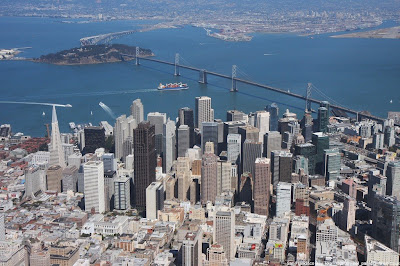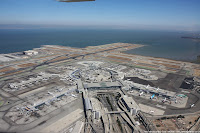
This has to be one of the most impressive flights you can do in the San Francisco Bay area, maybe in the whole of the USA? A tour of the San Francisco including Downtown, Alcatraz, The Golden Gate Bridge and everything in between. I had a few new challenges on this flight: first time through Class B airspace (SFO airport!), first time in a Cessna 172, and the first time with passengers. If you're planning a similar flight read on for tips.
Navigation and route planning
Planning the route and radio comss was an important part of the pre-flight as we were going to attempt to go through San Francisco International's class Bravo airspace. This is probably the most restrictive and busy airspace you would ever enter as a VFR (Visual Flight Rules) pilot in a small plane like a Cessna. You need permission from SFO Tower to enter the air space, and while you are there you will be given specific instructions on altitude and routing. I say attempt because there is a possibility they will not let you enter, for example if they already have a high workload of passenger jets etc.
 The route itself would take us through San Carlos before being handed over to SFO Tower and requesting entry to Bravo. While transitioning SFO's airspace it's likely they will route us west of the 101 freeway at 1500ft to keep us out of the way of other traffic. A few miles north of SFO we would leave class Bravo before being handed on to Norcal Approach while we do the tour around the city. The route back takes us down the west coast for a good view of highway 1 before heading back over the Santa Cruz mountains at Woodside and back into Palo Alto.
The route itself would take us through San Carlos before being handed over to SFO Tower and requesting entry to Bravo. While transitioning SFO's airspace it's likely they will route us west of the 101 freeway at 1500ft to keep us out of the way of other traffic. A few miles north of SFO we would leave class Bravo before being handed on to Norcal Approach while we do the tour around the city. The route back takes us down the west coast for a good view of highway 1 before heading back over the Santa Cruz mountains at Woodside and back into Palo Alto. Squawk codes and radio comms
Squawk codes and radio commsTo enter Class Bravo you need a squark code, and the easy way to do this is to ask for one from San Carlos Airport (SQL) while in the air. SQL have an arrangement with SFO where they can help manage traffic which plans to do a bay tour or transition Bravo when departing to the north. The squawk code is a unique number which is transmitted to the radar by our airplane's transponder. This allows the air traffic control to know who we are and where we are going rather than just being an unidentified blip on their screen. All of my flights until now have used the code 1200 which represents standard VFR, and is the same as all the other VFR planes not doing anything special.
Radio comms and notes from the tour
- 125.00 = "Palo Alto Ground, Cessna 734MK, Request taxi with Golf, Straight out departure through San Carlos for Bay tour"
- 118.60 = "Palo Alto Tower, Cessna 734MK ready at 31". The tower responds back with confirmation of destination and Clear to take off, runway 31
- 119.0 = "San Carlos Tower, Cessna 734MK, request transition, request squawk code for transition through Bravo for bay tour". SQL responds with clarification questions, and a unique squark code which must be entered into the transponder. "Squawk XXXX". We also had some traffic taking offin parallel from SQL heading out on a bay tour at the same time. This added some extra confusion with the next steps, in fact the SFO tower radio was so busy we had to do a couple of 360's over Bay Meadows race track before we reached the Bravo (we had to have permission to enter before we continued).
- 120.5 = "San Franciso Tower, Cessna 734MK, Orbiting over Bay Meadows at 2000ft, Squawking XXXX, Request Transition through Bravo for bay tour". The reply included permission to enter and instructions to keep west of the 101 freeway, at or below 1500ft.
- While transitioning SFO there were a few jets landing from the south each, and another taking off to the north west right through our intended flight path.
We had some warnings from SFO to avoid the wake turbulence, so we steered a little around where the jet had been. The challenge with wake turbulence is that you can't see it, and it can last for 2 minutes after the jet has left that particular position.
- As we left SFO Bravo we were handed over to NorCal approach, and told "resume own navigation".
- yyy.yy = "NorCal Approach, Cessna 734MK, just left San Francisco Airspace, at 1500ft, on bay tour" or something similar. From here we were being tracked by radar and monitored by NorCal Approach. This would give us traffic warnings if we were close to other planes on a bay tour etc. At this point we could do our own thing, including flying round the city and the major landmarks you associate with San Francisco.
- On leaving the bay we requested termination of flight following and announced the end of our bay tour. Past of the r
eply was "Squawk VFR", which meant we needed to change the transponder back to 1200. We left the radio on NorCal approach frequency so we could hear other traffic. This turned out to be a useful decision as there was a large jet taking off from SFO and heading straight over our path as we passed down the west coast - another chance of wake turbulence.
- 122.80 = CTAF for HAF. Next radio freq was the Common Traffic Advisory Frequency for Half Moon Bay airport. This airport does not have a control tower, instead there is a frequency where everyone can communicate and manage themselves (see Columbia trip).
- 135.27 = PAO ATIS, for a check of the latest conditions at Palo Alto airport: Wind 340 degrees at 15 knots, few clouds at 10,000ft...
- 118.60 = "Palo Alto Tower, Cessna 734MK, over Woodside, Request landing with Hotel", reply was "Cessna 734MK, Palo Alto Tower, Ident and make left traffic". The Ident button on the transponder makes us flash on their radar screen. We were warned of some traffic orbiting SLAC, and later we requested a left base entry as PAO was not too busy. Left base entry requires aiming for shoreline ampitheatre and then turning left.
 After landing there was one last frequency change required to communicate with Palo Alto ground as we taxied back to the tie down.
After landing there was one last frequency change required to communicate with Palo Alto ground as we taxied back to the tie down.Test both radios!
734MK has two sets of radios. This makes things a little easier when switching between so many frequencies, but it's essential to test both radios before take off. We made the mistake of testing one radio but not the second, which had its volume turned right down. Of course this didn't give SQL a very good impression! Next time I'll use one radio for ground, and test the other with Palo Alto Tower, or at least listen briefly to something like the ATIS with each radio to test the volume.
Flying the Cessna 172
How was my first flight in the bigger 172? Actually pretty good. The aircraft felt a lot bigger on the inside than the 152, but as it was from the same year the instruments were pretty much the same, as was the pre-flight procedure. The landing felt quite different, it was clear the extra weight of the 172 meant that it was less affected by the wind etc on the approach. Also the bigger engine had a lot more power than the 152's.
Landing the 172 - on YouTube!
One of the passengers filmed the landing, see below or click here.
No comments:
Post a Comment